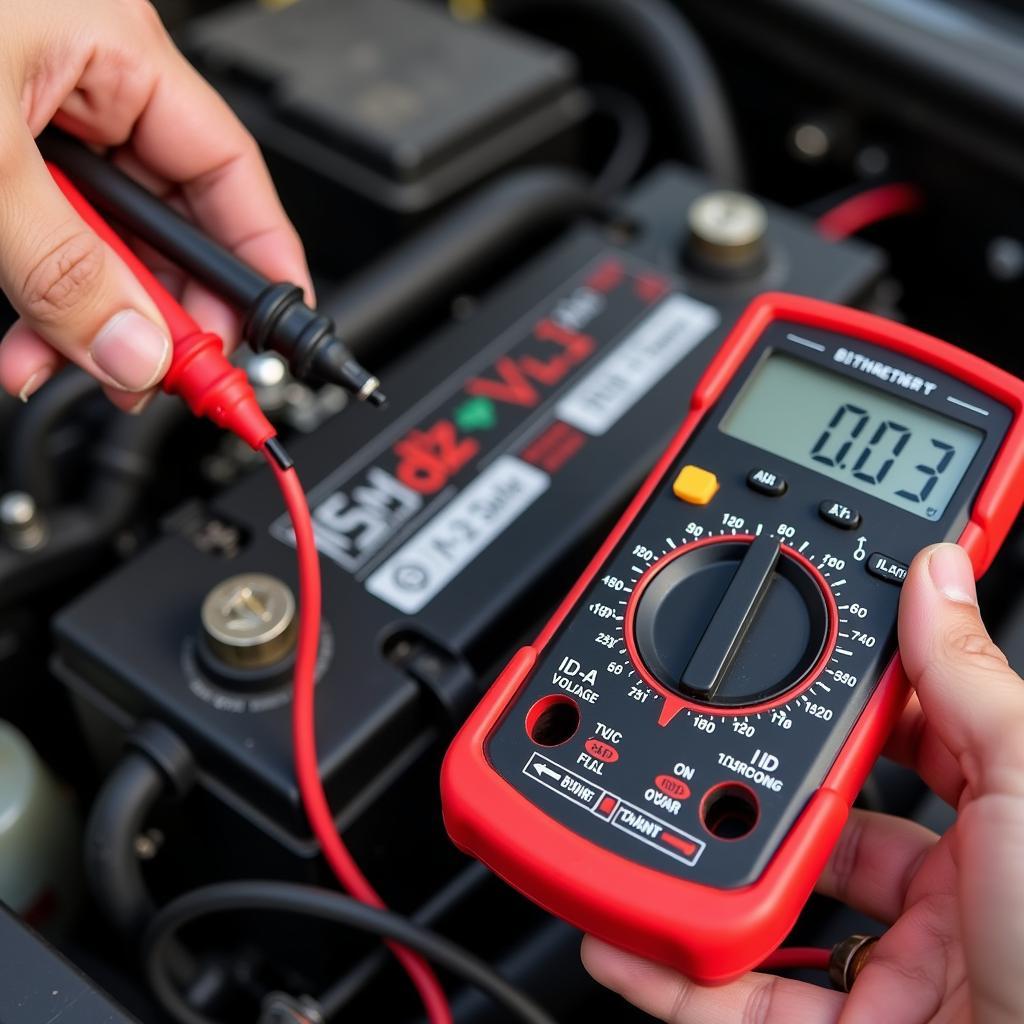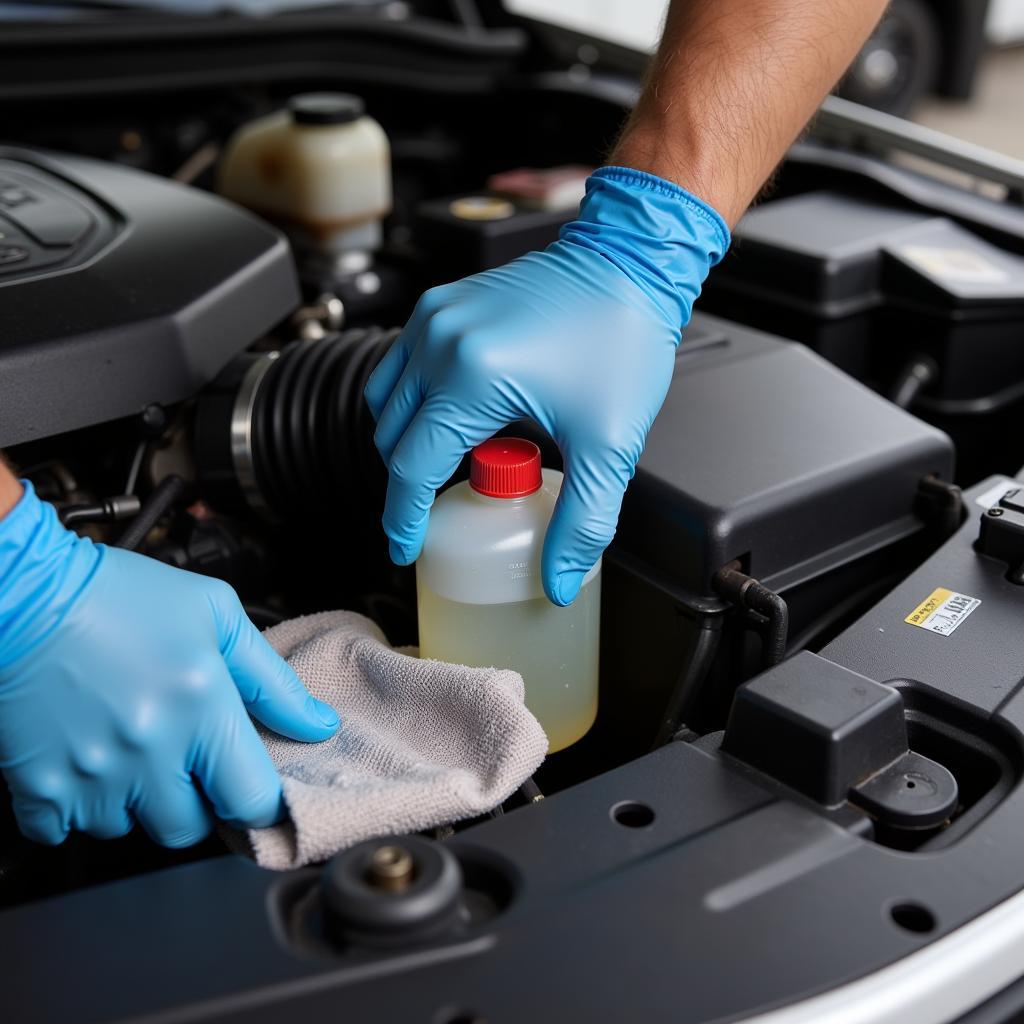A dead battery or a dead alternator? Both can leave you stranded, but knowing the difference is crucial for a quick fix. This guide helps you diagnose whether your car’s suffering from a dead alternator vs dead battery, empowering you to get back on the road quickly. We’ll explore the symptoms, testing methods, and solutions for each scenario. bad battery vs starter
Identifying a Dead Battery
A dead battery is a common culprit for starting issues. The battery stores the electrical energy needed to start your engine and power accessories when the engine is off. When it fails, your car simply won’t start. Common signs of a dead battery include:
- Dim headlights or interior lights, especially when the engine isn’t running.
- Clicking sound when turning the key, indicating insufficient power to crank the engine.
- Slow engine cranking.
- Electrical accessories malfunctioning or not working at all.
A simple jump-start can usually get your car going with a dead battery. However, it’s essential to determine why the battery died in the first place to prevent future occurrences. A faulty alternator or parasitic drain could be the underlying cause.
Recognizing a Dead Alternator
The alternator is your car’s power generator. It charges the battery while the engine is running and powers the electrical system. A failing alternator can lead to a drained battery and eventual breakdown. Here are some telltale signs of a dead alternator:
- Dim or flickering headlights that worsen as the engine revs.
- Dashboard warning light (battery icon) illuminated.
- Strange noises, like whining or growling, coming from under the hood.
- Electrical accessories, like the radio or power windows, malfunctioning or working intermittently.
- Battery dying repeatedly, even after being jumped or replaced.
Unlike a dead battery, jumping a car with a dead alternator won’t provide a long-term solution. The car will likely die again once the jump cables are removed, as the alternator isn’t recharging the battery.
Testing for a Dead Battery or Alternator
Here are simple tests to diagnose the problem:
Jump-Start Test: If the car starts and runs after a jump-start but dies again shortly after removing the cables, it likely points to a faulty alternator.
Voltage Test: Using a multimeter, check the battery voltage with the engine off. A reading below 12.6 volts suggests a weak or dead battery. Start the engine and check the voltage again. A healthy alternator should maintain a voltage between 13.5 and 14.5 volts. car battery going dead signs
“Using a multimeter can save you time and money by pinpointing the exact issue,” says seasoned auto electrician, Robert Johnson. “It’s a simple test anyone can perform with a little guidance.”
Addressing the Problem
Once you’ve diagnosed the issue, take appropriate action:
Dead Battery: If the battery is the culprit, replace it with a new one. dead battery or starter
Dead Alternator: A failing alternator needs to be replaced or rebuilt by a qualified mechanic. Continuing to drive with a dead alternator can damage other electrical components and leave you stranded.
 Testing Car Battery and Alternator
Testing Car Battery and Alternator
Dead Alternator vs Dead Battery: Key Differences Summarized
The following table summarizes the key differences between a dead alternator and a dead battery:
| Feature | Dead Battery | Dead Alternator |
|---|---|---|
| Starting | Clicking sound or slow cranking | May start initially, then die |
| Headlights | Dim, especially when engine is off | Dim or flickering, worsen when engine revs |
| Electrical Accessories | Malfunction or don’t work | May work intermittently or malfunction |
| Jump-Start | Usually starts and runs | Starts but dies again after cables are removed |
| Battery Voltage (engine off) | Below 12.6V | May be normal initially, then drops |
| Battery Voltage (engine running) | Below 13.5V | Below 13.5V |
“Regular maintenance, including checking your battery and alternator, can prevent these issues and keep your car running smoothly,” advises Johnson. “It’s a small investment that can save you a lot of hassle in the long run.” battery discharge problem in car
Conclusion: Don’t Get Stranded – Know the Difference
Understanding the difference between a dead alternator vs dead battery can save you time, money, and frustration. By recognizing the symptoms and performing simple tests, you can quickly diagnose the problem and take the necessary steps to get back on the road. Remember, regular maintenance is key to preventing these issues and ensuring the long-term health of your vehicle. battery vs alternator symptoms
FAQ
-
Can a bad alternator drain a good battery? Yes, a faulty alternator won’t charge the battery, leading to eventual depletion.
-
How long can you drive with a bad alternator? You can drive for a limited time, usually until the battery is completely drained.
-
Can I test my alternator myself? Yes, you can perform a simple voltage test with a multimeter.
-
How much does it cost to replace an alternator? The cost varies depending on the car model and labor rates.
-
How much does it cost to replace a car battery? Battery prices vary depending on type and size.
-
Can a bad battery damage the alternator? A severely discharged or shorted battery can put extra strain on the alternator, potentially causing damage.
-
What are the signs of a parasitic battery drain? Signs include a dead battery after periods of inactivity, dimming lights, and slow engine cranking.

